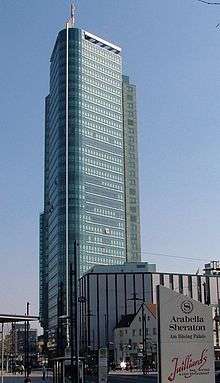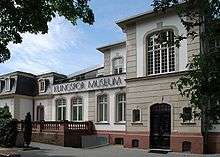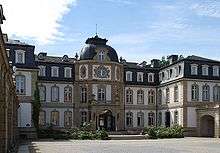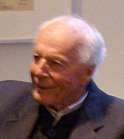Offenbach am Main
| Offenbach am Main | |||
|---|---|---|---|
|
Offenbach on the Main river | |||
| |||
 Offenbach am Main | |||
| Coordinates: 50°6′0″N 8°48′0″E / 50.10000°N 8.80000°ECoordinates: 50°6′0″N 8°48′0″E / 50.10000°N 8.80000°E | |||
| Country | Germany | ||
| State | Hesse | ||
| Admin. region | Darmstadt | ||
| District | Urban district | ||
| Government | |||
| • Mayor | Horst Schneider (SPD) | ||
| Area | |||
| • Total | 44.90 km2 (17.34 sq mi) | ||
| Elevation | 98 m (322 ft) | ||
| Population (2015-12-31)[1] | |||
| • Total | 123,734 | ||
| • Density | 2,800/km2 (7,100/sq mi) | ||
| Time zone | CET/CEST (UTC+1/+2) | ||
| Postal codes | 63001 - 63075 | ||
| Dialling codes | 069 | ||
| Vehicle registration | OF | ||
| Website | www.offenbach.de | ||
Offenbach am Main (German pronunciation: [ˈɔfn̩bax ʔam ˈmaɪn]) is a city in Hesse, Germany, located on the left bank of the river Main and part of the Frankfurt Rhein-Main urban area. Offenbach has a population of 126,934.[2]
In the 20th century the city's economy was dominated by the machine-building and leather industries, and it was also a major centre of the typography and design industries. Other important industries are the automobile and pharmaceutical industries. During the Second World War the city suffered heavily from bombing by the Allied Forces. More than half of the city's population have a non-German background, with Turks, former Yugoslavs, Arabs, Italians, Greeks and Poles as major groups.
Geography
Subdivisions
The inner town of Offenbach is quite large and has only a few suburbs. In the east the three incorporated: Bürgel (incorporated 1908), Bieber (incorporated April 1, 1938), and Rumpenheim (incorporated April 4, 1942). In the south are the newer suburbs Lauterborn and Rosenhöhe, Tempelsee, the office town Kaiserlei and the industrial area Waldheim. The newest suburb is Mathildenviertel in the center near to the Main river.[3]
History
.jpg)

The first documented reference to a suburb of Offenbach appears in 770.[4] In a document of the Holy Roman Emperor Otto II dating to 977 exists the first mention of the place of Offenbach.[5] During the Middle Ages Offenbach passed through many hands. Only in 1486 could the Count Ludwig of Isenburg finally take control of city for his family, and 1556 Count Reinhard of Isenburg relocated his Residence to Offenbach, building a palace, the Isenburger Schloß (Isenburg Palace), which was completed in 1559. It was destroyed by fire in 1564 and rebuilt in 1578.
In 1635 Offenbach given to the Landgraves of Hesse-Darmstadt but it was returned to the Isenburg-Birstein Count (later Prince) in 1642 and remained in that Principality until 1815 when the Congress of Vienna gave the city to the Austrian Emperor, Francis I. A year later it was given to the Grand Duchy of Hesse-Darmstadt.
Always very close to the city centre of Frankfurt, Offenbach was a popular location for business. The town has its own trade fair, and many companies have opened facilities here because there are fewer restrictions and no closed businesses. French Protestants (Huguenots) came in the 17th century and settled in Offenbach and contributed to making Offenbach a prosperous city, e.g., bringing knowledge of tobacco with them and turning Offenbach into a centre for rolling cigars. The town was more cosmopolitan than Frankfurt; famous people such as Goethe and Mozart visited it several times.
The Rumpenheim Palace and its park were a popular destination for monarchs in the 19th century. The city was thereafter ruled by Grand Dukes of Hesse and by Rhine until the monarchy was abolished in 1918. Offenbach became the center of the traditional design with figures such as the architect Hugo Eberhardt, the typographer Rudolf Koch, the bookbinder and designer Ignatz Wiemeler and Ernst Engel and the painter Karl Friedrich Lippmann.
During the Second World War a third of the city was destroyed by Allied bombing, which claimed 467 lives. With the new district Lauterborn the city was expanded to the south in the 1960s. On the border with Frankfurt, the office district Kaiserlei was built. Offenbach is a so-called ´Sozialer Brennpunkt`(= multiple social problems area) because of unemployment, poverty, gang related crime and migration.[6]
Governance
Mayors from 1824 - present
- 1824–1826: Peter Georg d'Orville
- 1826–1834: Heinrich Philipp Schwaner
- 1834–1837: Peter Georg d'Orville
- 1837–1849: Jonas Budden
- 1849–1859: Friedrich August Schäfer
- 1859–1867: Johann Heinrich Dick
- 1867–1874: Johann Martin Hirschmann
- 1874–1882: Hermann Stölting
- 1883–1907: Wilhelm Brink
- 1907–1919: Andreas Dullo
- 1919–1933: Max Granzin
- 1947–1949: Johannes Rebholz
- 1950–1957: Hans Klüber
- 1957–1974: Georg Dietrich
- 1974–1980: Walter Buckpesch
- 1980–1986: Walter Suermann
- 1986–1994: Wolfgang Reuter
- 1994–2006: Gerhard Grandtke
- 2006–: Horst Schneider
Town twinning
Offenbach am Main is twinned with:[7]
|
Demographics
Offenbach has a large non-German population. In 2016, foreign nationals made up 37% of the population.[9] The largest communities are, in that order, from Turkey, Greece, Romania, Poland and Italy.[10] According to census data Offenbach and Duisburg had the highest share of muslim migrants of all German districts in 2011. [11]
Population history

Until the end of the 17th century, Offenbach remained a small town with less than a thousand habitants. With the coming into power of the count Johann Philipp in 1685, the city began to develop and the population rose steadily. In the 19th century the city became industrialized and the population increased even tenfold.[12] Offenbach is one of the German cities where Germans without migrant background make up a minority of the population. As of 31 December 2012, approx. 44.3% of residents or 55,047 people had no foreign background. In contrast to that, there were 55.7% or 69,214 people of non-German descent.[13] The largest of those groups are:[14]
Turks: 15,000 or 12.2%
People from the former Yugoslavia (e.g. Serbs, Croats): 13,000 or 10.5%
Arabs: 8,000 or 6.5%
Italians: 8,000 or 6.5%
Greeks: 7,500 or 6.0%
Poles: 4,000 or 3.2%
Afghans: 3,600 or 3%
Pakistanis: 2,700 or 2.2%
|
|
|
|
| Rank | Nationality | Population (2014) |
|---|---|---|
| 1 | 6,309 | |
| 2 | 4,698 | |
| 3 | 4,359 | |
| 4 | 3,742 | |
| 5 | 3,193 | |
| 6 | 2,459 | |
| 7 | 1,390 | |
| 8 | 1,284 | |
| 9 | 1,222 | |
| 10 | 886 |
Economy

Until the early 1970s Offenbach was dominated by the machine-building and leather industries. The city hosts the German Association for Electrical, Electronic and Information Technologies to this day. The Deutscher Wetterdienst, commonly abbreviated as DWD, (translated from German as German Meteorological Service), residing in the Westend district.
Offenbach was also the European center of typography, with Gebr. Klingspor and Linotype (inventors of Optima or Palatino typeface) moving to nearby Eschborn in the 1970s and MAN Roland printing machines still a major employer today. Typography and design still remain important with a cluster of graphic design and industrial design companies, as well as the university level Hochschule für Gestaltung Offenbach am Main design school and the Klingspor Museum.
In recent years Offenbach has become a popular location for a wide array of services, especially from the transport sectors. Offenbach is the host to the European headquarters of Honda,[15] Hyundai Motors[16] and Kumho Tires.[17]
Image gallery
- An office building in Offenbach-Kaiserlei
 A printing machine produced by Manroland
A printing machine produced by Manroland Honda Small Hybrid Concept developed in Offenbach
Honda Small Hybrid Concept developed in Offenbach The Sheraton Offenbach
The Sheraton Offenbach
Arts and culture
Attractions


In Offenbach there is no specific Old Town, but there are several buildings which survived bombing during the war and have been restored. One of them is the Neo-baroque palace Büsingpalais with the Büsingpark, reconstructed in the 1980s. Today it is used as a congress center close to the Sheraton hotel. Between the shopping area and the Main, is the Lilipark and the Lilitemple, named after Johann Wolfgang von Goethe's fiancee Lili Schönemann. The most important building is the Isenburger Schloss (Isenburg Palace), a renaissance palace from 1576. It is today used by the Offenbach Design University which is next to it. There is also a neoclassic palace in the borough Rumpenheim, the Rumpenheimer Schloss it now serves exclusively as domestic dwellings but the park is public.
- Isenburger Schloss, a Renaissance building, now used by the Offenbach Design University
- Büsingpalais with Büsingpark
- Wilhelmsplatz a square with coffee houses and three times a week a market.
- Buildings of the French Protestant Church and the French Protestant Community.
- Rumpenheim Palace.
- Former Synagogue "Capitol" (now a concert hall next to the new Synagogue).
- The Westend Quarter (19th century).
- Several art deco apartment houses.
- Buildings by early 20th century architect Hugo Eberhardt: "Heyne" Factory, main building of the Design University, AOK Insurance building.
- Prefabricated houses by Egon Eiermann in Lauterborn
Events
There are several festivals in Offenbach, some of these are:
- Lichterfest im Büsing-Park (festival of lights in the park of the Büsing palais)
- Nacht der Museen (with Frankfurt)
- Mainuferfest
- Cross Media Night
Museums
- German Leather Museum
- Klingspor Museum, museum of typography and calligraphy
- Haus der Stadtgeschichte, municipal historical museum
- Rosenheim-Museum for the painter Bernd Rosenheim
Gallery
 Isenburger Schloss
Isenburger Schloss Büsingpalais
Büsingpalais Rumpenheimer Schloss
Rumpenheimer Schloss The market on Wilhelmsplatz
The market on Wilhelmsplatz Detail at the building of the HfG, designed by Hugo Eberhardt
Detail at the building of the HfG, designed by Hugo Eberhardt A typical street in Offenbach
A typical street in Offenbach- The municipal hospital
 The house where Rudolf Koch lived, one of the art deco houses in the southwestern part of the town
The house where Rudolf Koch lived, one of the art deco houses in the southwestern part of the town
Sports
Offenbach hosts the German association football club Kickers Offenbach. The club was founded in 1901.
Infrastructure
Transport


Roads
The streets of central Offenbach are usually congested with cars during the rush hour. Some areas, especially around the shopping streets, are pedestrian-only streets. There are numerous car parks located throughout the city. The Offenbacher Kreuz is an Autobahn interchange where the Autobahnen A 3 (Cologne-Würzburg) and A 661 meet. The A661 crosses the A 3 (Cologne-Würzburg) and A 5 (Basel-Hannover).
Public transport
The city is connected by a major line of the S-Bahn railway system to Frankfurt. The station in the city center is Marktplatz. In general, six stations are located in Offenbach: Offenbach-Kaiserlei, Offenbach-Ledermuseum, Offenbach-Marktplatz, Offenbach-Ost, Offenbach-Bieber, Offenbach-Waldhof. Trains run every 5–10 minutes between Offenbach and Frankurt. A 24 hours Service between both cities was introduced in 2013. The journey from Offenbach Marktplatz to Frankfurt Main Station takes 15 minutes, Frankfurt Airport can be reached within 26 minutes. The city's public transportation services OVB and NIO connect all city districts to downtown by bus lines. Since the construction of the S-Bahn, the central train station, the Offenbach Hauptbahnhof, is no longer considered important.
Frankfurt Airport
The city is accessed from around the world via the Frankfurt Airport, (Flughafen Frankfurt am Main) which is located 12 kilometres (7.5 miles) from Offenbach. The airport can be reached by car or bus and has two train stations, one for regional and one for long-distance traffic. The S-Bahn lines S8 and S9 (direction "Offenbach Ost or "Hanau"), departing from the regional traffic station, take 25 minutes from the airport to get to Offenbach.
Notable residents
Notable people born in Offenbach include:
- Johann André (1741–1799), founder of the music publishing firm named after him

- Sven Beckert (born 1969) history professor at Harvard, winner of 2015 Bancroft Prize for Empire of Cotton
- Gottfried Böhm (born 1920) architect who won the Pritzker Architecture Prize in 1986
- Moritz Wilhelm August Breidenbach (1796–1857) a German jurist
- Bernard von Brentano, (1901–1964) writer, essayist and journalist
- Ray Bumatai, (1952–2005), born here, musician, actor and singer
- Heinrich von Brentano (1904–1964) a German conservative politician
- Christian Dell, (1882–1974) industrial designer, factory designer on Bauhaus
- Olli Dittrich, (born 1956), actor and comedian, born here
- Richard Heyne, (1882–1961), member of Landtag and producer
- Hans Hotter, (1909–2003), opera singer
- Philipp Mainländer in Offenbach, (1841–1876) born as Phillip Batz, poet and philosopher
- Prince Philipp of Hesse, (1896–1980), prince and governor
- Helene Mayer, (1910–1953), fencer, born here
- Tarek Al-Wazir, (born 1971), politician, Deputy of the Hessian Minister-President, born here
Others who have resided in Offenbach include:
- Rabbi Abraham Bing (1752–1841)
- Jacob Frank, (1726–1791), Jewish religious leader
- Rudi Völler, (born 1960), German football Player and -coach
- Cornelia Hanisch, (born 1952), German fencer, former world champion and 1984 Olympic gold medallist
- Heinrich Kaminski, (1886–1946), composer, worked here
- Friedrich Kellner, attended Goethschule here
- Karlgeorg Hoefer, calligrapher and typographer
- Regina Jonas, first female Rabbi, ordained in Offenbach
- Rudolf Koch, worked and taught here
- Fritz Kredel, studied here
- Philipp Mainländer, died here
- Götz Otto, (born 1967), German actor, born here
- Anthony Rother Electronic musician
- Snap!, German dance group
- Berthold Wolpe, notable typographer and type designer
- Krishan Lal, notable Business: Bavarian Shipping Lines

- Salomon Formstecher, rabbi and philosopher
 Gottfried Böhm, architect
Gottfried Böhm, architect
References
- ↑ "Bevölkerung der hessischen Gemeinden". Hessisches Statistisches Landesamt (in German). August 2016.
- ↑ "Einwohner der Stadt Offenbach am Main nach Statistischen Bezirken am 31.12.2013" (PDF). Melderegister Offenbach.
- ↑ "Antrag Magistratsvorlage Nr. 144/10". City of Offenbach. 21 April 2010. Retrieved 4 September 2016.
- ↑ Braun, Lothar (12 February 2004). "Offenbach und seine Vororte". City of Offenbach. Retrieved 4 February 2014.
- ↑ "Offenbach - Facts and Figures" (PDF). City of Offenbach. 2012. p. 2. Retrieved 4 February 2014.
- ↑ Presse, Frankfurter Neue. "Nach dem Tod von Tugce A.:". Retrieved 9 February 2017.
- ↑ "Offenbach und seine Partnerstädte". City of Offenbach. 21 April 2010. Retrieved 25 September 2016.
- ↑ "Puteaux - Qu'est-ce que le jumelage?". Mairie de Puteaux [Puteaux Official Website] (in French). Archived from the original on 2013-11-26. Retrieved 2013-12-28.
- ↑ Official statistics
- ↑ Official statistics for nationalities in 2016
- ↑ "Kartenseite: Muslime in Deutschland - Landkreise". kartenseite.wordpress.com. 2017-04-05. Retrieved 2017-04-29.
- ↑ "Offenbach - die kleine Großstadt am Main". City of Offenbach.
- ↑ "Einwohner mit Migrationshintergrund am 31.12.2012" (PDF). Melderegister Offenbach, MigraPro.
- ↑ "Bevölkerung mit Migrationshintergrund in Offenbach am Main : Erhebungsmethode und Ergebnisse" (PDF). Offenbach.de. Retrieved 2015-03-17.
- ↑ "Impressum." Honda. Retrieved on 22 April 2012. "Sprendlinger Landstraße 166 63069 Offenbach"
- ↑ "News & Events." Hyundai. Retrieved on 22 April 2012. "Kaiserleipromenade 5 63067 Offenbach"
- ↑ "Impressum." Kumho Tyres. Retrieved on 9 November 2011. "Brüsseler Platz 1 63067 Offenbach am Main"
External links
| Wikimedia Commons has media related to Offenbach am Main. |
-
 Offenbach travel guide from Wikivoyage
Offenbach travel guide from Wikivoyage - Offenbach website (in German)
-
 "Offenbach". Collier's New Encyclopedia. 1921.
"Offenbach". Collier's New Encyclopedia. 1921.



_1968%2C_MiNr_564.jpg)